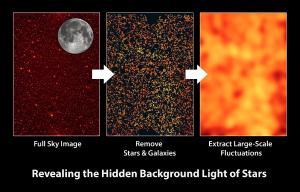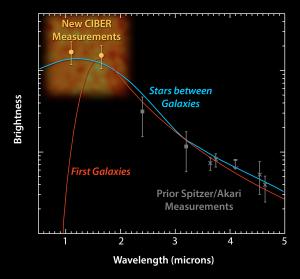Blog
All Alone in the Night
9 November 2014
 NASA/JPL-Caltech
NASA/JPL-CaltechAlthough we think of deep space as being dark, that isn’t entirely true. The universe is filled with a background glow of radiation. The most famous is the cosmic microwave background, which is the remnant glow of the big bang. There is also the x-ray background, caused by things like active galactic nuclei, and the radio background. This week new research on the infrared background has been published in Science, and the results are somewhat surprising.1
One of the challenges of measuring the infrared background is that lots of things in the universe emit infrared light. Stars, dust clouds, even distant galaxies all emit light in the infrared. To determine the infrared background the team had to remove all the known infrared sources such as local stars and galaxies. When they did this, they found the remaining background was brighter than expected.
One possible source for this extra light would be distant light from the earliest stars and galaxies. Because of their tremendous distance, their light is redshifted into infrared wavelengths. An excess of infrared background light would then indicate that there were more early galaxies than previously observed.
 NASA/JPL-Caltech
NASA/JPL-CaltechBut in this case the team noticed that the infrared background did something rather strange. Rather than getting dimmer as you move toward visible wavelengths, as you would expect with distant galaxies, the background got brighter. So it can’t be an effect of the first galaxies.
It’s not clear what the cause of this brightening is, but one idea is that it’s due to rogue stars in intergalactic space. While most stars exist within galaxies, some can be flung out through gravitational interactions with other stars, a process known as evaporation. These rogue stars are too dim to be seen individually, but their combined light would affect the overall infrared background.
If that’s the case, then there are far more rogue stars than we thought. A lot of stars to be all alone in the night.
Zemcov, Michael, et al. “On the origin of near-infrared extragalactic background light anisotropy.” Science 346.6210 (2014): 732-735. ↩︎